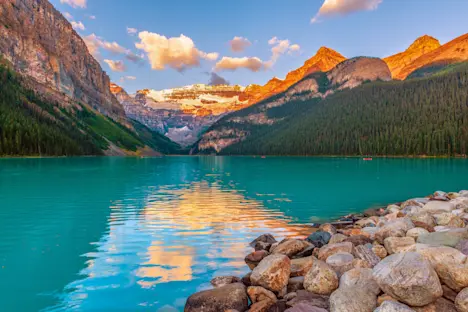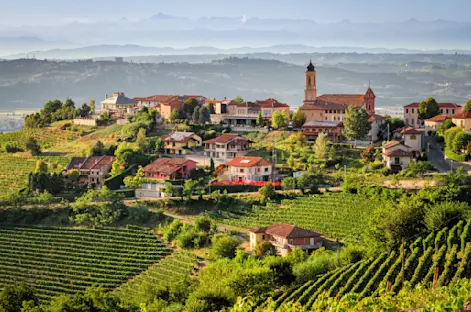Itinerary

Arrive at St. John’s International Airport where you’re met and transferred to our downtown hotel. Situated on the eastern tip of the Avalon Peninsula on the island of Newfoundland in Atlantic Canada, St. John’s is North America’s easternmost city and one of the continent’s oldest municipalities. Its rich cultural heritage blends Indigenous, English and Irish influences, some of which are on view in the downtown Quidi Vidi Trail, a series of interpretive panels and artwork. If time permits, explore on your own before gathering this evening for a welcome dinner and orientation with our Expedition Leader.
Our adventure begins with a boat cruise around Witless Bay, where nutrient-rich waters attract large numbers of migrating humpback whales each summer that feed, breach and slap the water in exciting displays of activity. Keep an eye out for minke whales, too, plus blue and sperm whales, though such sightings are less common. Seabirds are also a highlight. The Witless Bay Ecological Reserve comprises four islands that are home to North America’s largest Atlantic puffin colony, with half a million puffins returning each spring and summer to nest. It is also a significant breeding site for about 50% of the Newfoundland and Labrador population of black-legged kittiwakes, and home to the world’s second-largest storm petrel colony, with more than 620,000 nesting pairs. Among the hundreds of thousands of seabirds nesting in Witless Bay, we also find murres, herring gulls, razorbills and black guillemots.
Continue to Petty Harbour-Maddox Cove, one of the oldest European settlements in North America. Continuously occupied since at least 1598, the town’s current population of about 950 sustains itself with fishing and ecotourism. There’s ample time to explore the maritime village on foot before a traditional Newfoundland seafood dinner and catching the sunset at the historic Cape Spear Lighthouse.
A scenic three-hour drive takes us from St. John’s to Trinity, the coastal village where The Shipping News was filmed, and our destination for the next three nights. After lunch, head to sea in search of Newfoundland’s abundant whales on a two-hour private marine safari aboard an RHIB—a Rigid Hull Inflatable Boat, offering agility that bigger vessels lack. The largest annual whale migration in the northern hemisphere begins off the Newfoundland coast in early June, with various species present until September or later. With our boat’s low profile, we hope to get close enough to observe whales as they breach, feed and play. Following the coastline of Trinity Bay, passing scattered islands and remote communities, scout for humpback, fin, sperm and minke whales, orcas, dolphins and porpoises, seals, basking sharks, eagles, and seabirds, including puffins, gannets and more. Return to Trinity to enjoy some free time this afternoon before dinner in town.
Today’s focus is the dramatic coast of the Bonavista Peninsula, which is home to hundreds of nesting pairs of Atlantic puffins. From Elliston, we take a short walk to the colony that roosts on a rocky outcrop, offering a close vantage for the best land-based puffin viewing in North America. Exploring the geology and natural history of the area, we witness the power of the ocean to relentlessly erode and reshape the soft sedimentary rock shoreline. This phenomenon is vividly demonstrated by a dramatic feature at Discovery UNESCO Global Geopark called The Dungeon. A large sinkhole formed by the collapse of two adjacent sea caves, The Dungeon will one day erode to become a single pillar known as a sea stack. We also visit Cape Bonavista Lighthouse, one of the most photographed in Newfoundland. Built in 1843 and painted in the classic red-and-white style of the region, the lighthouse contains a rare 19th-century catoptric lamp system that once burned seal oil to produce light.
Return to Trinity for a fun evening at Rising Tide Dinner Theater, a renowned drama company in operation since 1978. Producing plays that celebrate the province’s storied past and contemporary voices, the company’s performances are equally entertaining and educational. When weather permits, many performances take place outdoors.
Return to the sea this morning to look for more marine life on a private half-day whale-watching cruise. After lunch, enjoy a guided walking tour of historic Trinity. Trinity's rich heritage dates back more than 500 years, and we learn about the history of its many inhabitants over the centuries, including the Beothuk Indigenous people, and French, Irish and English settlers. Experience Trinity's magnificent cultural history through stories, photos, burial records, shipwrecks and disasters as we time-travel through Newfoundland with our acclaimed local guide, a Trinity native whose ancestors arrived in the "New Founde Land" from Dorset, England in the early 1800s. Later this afternoon, choose between free time in town or a hike on the Skerwink Trail led by our Expedition Leader. The route offers striking views of the rugged coastline, sea stacks, arches and beaches. Scan the deep blue ocean for humpback and minke whales, and watch seals bask on the rocks at the base of cliffs. Seabirds abound, and we frequently see bald eagles soaring overhead. This evening, depart for Fort Point where we gather for a classic Newfoundland summer dinner: a seafood boil by the ocean.
From Gander, a small town that gained international recognition after the 9/11 attacks when it welcomed stranded passengers whose planes were diverted due to the closure of American air space, we board a private flight to Blanc Sablon, a village on the north coast of the Gulf of St. Lawrence. Here, we transfer to a small bus and drive along the Labrador coast to Mary's Harbour where we board a ferry for a scenic ride through the waters of the Labrador coast. Weaving through narrow channels and passing various islands, our route takes us through calm inlets where seals, whales and other marine life congregate.
As we approach Battle Island, brightly painted cottages come into view, scattered along the hill overlooking the historic settlement. Ashore, step back in time as we explore this restored former fishing outpost. Despite its isolation and exposure to the harsh elements, Battle Harbour was once known as the “Capital of Labrador.” For centuries, it served as an economic and cultural stronghold for the region’s sparsely populated southeast coast, sustaining a thriving fishing community until the 1990s when the cod fishery drastically declined and the permanent settlement was abandoned. Restored by the Battle Harbour Historical Trust, Battle Harbour today is a car-free island without cell service or reliable Wi-Fi, offering overnight visitors a quiet and immersive experience.
A tour of the settlement brings Battle Harbour’s past to life. From the shoreline, scan the horizon for whales or look for Arctic fox as you traverse the small island on one of the many hiking trails that wend among Arctic vegetation and quirky rock formations. A sanctuary from modern distractions, Battle Harbour provides time and space to truly appreciate this grand landscape that has captivated people for centuries.
Over the course of two days, delve into Battle Harbour’s origins as a fishery in the early 1770s, where fishermen would salt and preserve their catches. Witness its evolution into a thriving 19th-century fishing community and its modern incarnation as a living museum. Through interactive experiences and guided tours, gain insight into the resilience and determination that allowed this isolated community to thrive in the face of harsh conditions as it relied on the bounty of the sea. Battle Harbour’s well-preserved buildings, including its red-and-white striped lighthouse, salt fish and merchant’s premises, offer a tangible link to the island’s heritage.
On a popular short hike, wander through once-thriving communities, now abandoned, which offer a glimpse into the past. Stroll to Cape St. Charles, the easternmost point in North America, for views that have remained virtually unchanged for centuries. Explore Battle Harbour’s maritime heritage on a private boat tour along the island’s shoreline, or participate in a hands-on baking experience, learning to create sweet buns that have been an island staple for generations.

An early morning ferry ride returns us to Mary’s Harbour, looking for whales along the way. Ashore, we turn south to follow the Labrador coastline, passing Red Bay National Historic Site. With UNESCO World Heritage status, Red Bay encompasses the remains of a major 16th-century Basque whaling operation, attracting nearly 2,000 Basque whalers from Spain and France. They hunted bowhead and right whales, both currently endangered species, for their oil, used primarily as fuel for lighting in Europe at the time. Today, the archaeological remains include shipwrecks, rendering ovens, cooperages, and a cemetery containing the remains of 140 whalers. L’Anse Amour, our next stop, is the oldest known burial mound in North America. Located in one of the largest and longest-used Aboriginal habitation sites in Labrador, occupied by the Maritime Archaic people between 9,000 and 2,000 years ago, the low circular mound of large stones measures about 25 feet in diameter. We also see Atlantic Canada’s tallest lighthouse at Point Amour, rising 109 feet above the Strait of Belle Isle. Then it’s time to return to Newfoundland as we board another ferry this evening, watching for more marine life as we cross the strait.

The fishing village of Port au Choix is home to a small resident caribou herd accustomed to human presence, which we go in search of this morning. While sightings are never guaranteed, we often have a chance for close observation and photo opportunities. Continue to Gros Morne National Park, acclaimed for its dramatic geology that provides a rare visible illustration of plate tectonics and the process of continental drift. A UNESCO World Heritage Site, the park contains exposed rocks from the earth’s mantle and oceanic crust, which were thrust to the surface of the earth through a process called subduction around 500 million years ago. The geology also showcases events that occurred around 1.2 billion years ago when the ancient continental margin of North America collided with another continent and formed a vast mountain range. Explore this fascinating phenomenon this afternoon on a private boat ride on Western Brook Pond. Steep rock walls rising 2,000 feet high surround this spectacular fjord created by receding glaciers. Fed by Stag Brook and refreshed with numerous waterfalls, the pond formed when land rebounded following the melting of the glacier, creating a natural dam. Continuing to Bonne Bay, we transfer to Gros Morne Inn for two nights. The remainder of the afternoon is free to enjoy the cedar sauna or hot tubs, or relax on the patio by the fire pit before dinner.
Today we get a rare glimpse into an intriguing slice of the planet’s geology at Tablelands, a glaciated landscape comprised of exposed mantle rock typically found deep within Earth’s interior. Orange-brown in color, the rock, called peridotite, creates a barren landscape that stands in stark contrast to the surrounding verdant hills and valley. The terrain is devoid of vegetation due to a heavy concentration of metals that are toxic to most—but not all—plants. Perhaps not surprisingly, given the otherworldly atmosphere of the landscape, several carnivorous plants thrive here, and we view the most prolific, which survive mainly on insects. After lunch, visit local artist studios in Bonne Bay, or simply enjoy the serene setting of the Gros Morne Inn. Gather this evening for a festive farewell dinner, reveling in our shared discovery of this lesser-known side of Canada.
Transfer to Deer Lake Regional Airport for departing flights home.

































